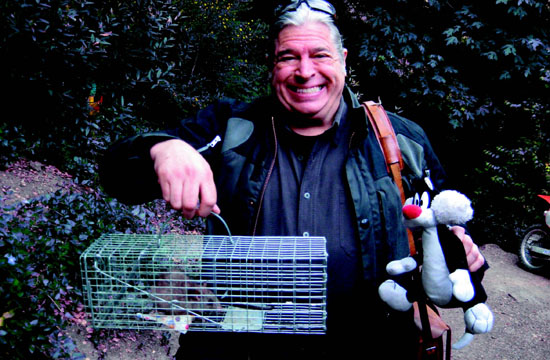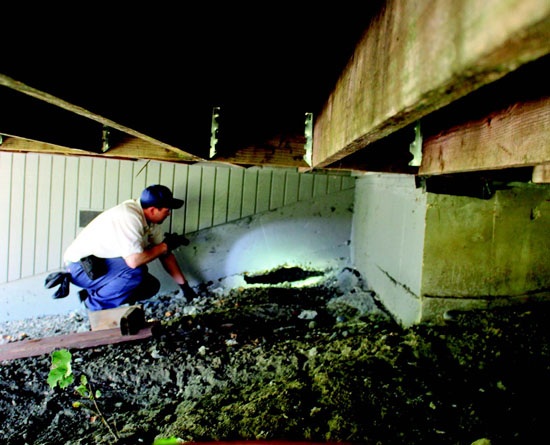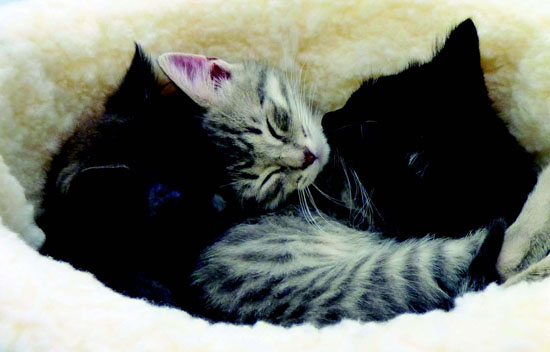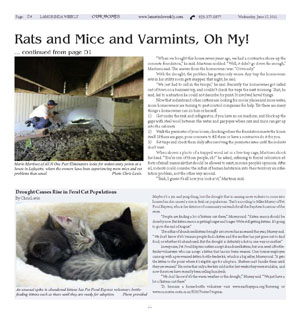|
|
Published June 17th, 2015
|
Rats and Mice and Varmints, Oh My!
|
| Drought causing more infestations in Lamorinda homes |
| By Chris Lavin |
 |
| Michael Rochette of Canyon proudly displays a wood rat he caught in the lower level of his house, using a live trap. He gave the credit to Sylvester the Cat. The rat was released far, far away. Photo Chris Lavin |
Mario Martinez started his own pest-control business about four years ago. He now has 10 employees, and the phone hasn't stopped ringing. Lately it's been worse. (Or better, if one looks at it from his perspective.) On a recent day, he pulled his white truck full of traps and other apparatus to a one-story home in Lafayette that had an understory and unfortunately an infested attic, and knocked on the door.
 "I am so glad to see you," the bare-footed homeowner said when he opened the door. "I've waited too long."
"I am so glad to see you," the bare-footed homeowner said when he opened the door. "I've waited too long."
 Martinez knew exactly what he meant. Martinez has had more calls than ever, because this year's drought has caused a plethora of our usually docile resident rodent creatures that we feel should and will continue to live only in the adjacent areas to our houses - over there out there, somewhere. Now more rats and mice and other creatures are looking for water and are coming into houses at a high rate, especially in places that border creeks.
Martinez knew exactly what he meant. Martinez has had more calls than ever, because this year's drought has caused a plethora of our usually docile resident rodent creatures that we feel should and will continue to live only in the adjacent areas to our houses - over there out there, somewhere. Now more rats and mice and other creatures are looking for water and are coming into houses at a high rate, especially in places that border creeks.
 "Does your house sound like this?" Martinez asked when he stepped into the Lafayette foyer, and scrabbled his fingers against the wall. "Oh, yeah," the homeowner said. "They're in the walls, the attic. They're everywhere."
"Does your house sound like this?" Martinez asked when he stepped into the Lafayette foyer, and scrabbled his fingers against the wall. "Oh, yeah," the homeowner said. "They're in the walls, the attic. They're everywhere."
 "Kitchens are the main destination," said Martinez, of All N One Pest Control. He has seen an increase in rats, especially Norway rats, and mice. "Laundry rooms, too. Anywhere there is a pipe leading into the house usually means there is an opening bigger than the pipe. That's what has to be fixed."
"Kitchens are the main destination," said Martinez, of All N One Pest Control. He has seen an increase in rats, especially Norway rats, and mice. "Laundry rooms, too. Anywhere there is a pipe leading into the house usually means there is an opening bigger than the pipe. That's what has to be fixed."
 The biggest problem homeowners face, according to Bill Snider at Ace Hardware in Moraga, is "they see a rat," he says. "One rat. So they think they have one rat. If you see a rat, it's not a sole rat. It has family. One trap isn't going to do it. People don't want to do what it takes, and check the perimeter of their houses, to find out where they are getting in."
The biggest problem homeowners face, according to Bill Snider at Ace Hardware in Moraga, is "they see a rat," he says. "One rat. So they think they have one rat. If you see a rat, it's not a sole rat. It has family. One trap isn't going to do it. People don't want to do what it takes, and check the perimeter of their houses, to find out where they are getting in."
 Martinez completely agrees. He is an expert in walking the perimeter. On his visit to the Layafette house on Quail Run, he started by walking around and under the house. He found several holes where invaders even the size of a raccoon could go in, set up shop, start a family, and install cable TV.
Martinez completely agrees. He is an expert in walking the perimeter. On his visit to the Layafette house on Quail Run, he started by walking around and under the house. He found several holes where invaders even the size of a raccoon could go in, set up shop, start a family, and install cable TV.
 "This place needs a lot of cement work," he said. When he broke the news to the homeowner, the owner nodded knowingly.
"This place needs a lot of cement work," he said. When he broke the news to the homeowner, the owner nodded knowingly.
 "When we bought this house seven years ago, we had a contractor shore up the concrete foundation," he said. Martinez nodded. "Well, it didn't go down far enough," Martinez said. The answer from the homeowner was: "Obviously."
"When we bought this house seven years ago, we had a contractor shore up the concrete foundation," he said. Martinez nodded. "Well, it didn't go down far enough," Martinez said. The answer from the homeowner was: "Obviously."
 With the drought, the problem has gotten only worse. Any trap the homeowner sets in his utility room gets snapped that night, he said.
With the drought, the problem has gotten only worse. Any trap the homeowner sets in his utility room gets snapped that night, he said.
 "We just had to call in the troops," he said. Recently the homeowner got called out of town on a business trip, and couldn't check the traps the next morning. That, he said, led to a situation he could not describe for print. It involved larval things.
"We just had to call in the troops," he said. Recently the homeowner got called out of town on a business trip, and couldn't check the traps the next morning. That, he said, led to a situation he could not describe for print. It involved larval things.
 Now that rodents and other critters are looking for cooler places and more water, more homeowners are turning to pest control companies for help. Yet there are many things a homeowner can do him or herself.
Now that rodents and other critters are looking for cooler places and more water, more homeowners are turning to pest control companies for help. Yet there are many things a homeowner can do him or herself.
 1) Get under the sink and refrigerator, if you have an ice machine, and block up the gaps with steel wool between the water and gas pipes where rats and mice can get up into the cabinets.
1) Get under the sink and refrigerator, if you have an ice machine, and block up the gaps with steel wool between the water and gas pipes where rats and mice can get up into the cabinets.
 2) Walk the perimeter of your house, checking where the foundation meets the house itself. If there are gaps, pour concrete to fill them or have a contractor do it for you.
2) Walk the perimeter of your house, checking where the foundation meets the house itself. If there are gaps, pour concrete to fill them or have a contractor do it for you.
 3) Set traps and check them daily after resolving the perimeter issue until the rodents don't visit.
3) Set traps and check them daily after resolving the perimeter issue until the rodents don't visit.
 When shown a photo of a trapped wood rat in a live-trap cage, Martinez shook his head. "You're one of those people, eh?" he asked, referring to forced relocation efforts of small mammals that should be allowed to exist, in some people's opinions. After all, rodents could consider the influx of human habitation into their territory an infestation problem, not the other way around.
When shown a photo of a trapped wood rat in a live-trap cage, Martinez shook his head. "You're one of those people, eh?" he asked, referring to forced relocation efforts of small mammals that should be allowed to exist, in some people's opinions. After all, rodents could consider the influx of human habitation into their territory an infestation problem, not the other way around.
 "Yeah, I guess it's all how you look at it," Martinez said.
"Yeah, I guess it's all how you look at it," Martinez said.

|
| |
 |
| Mario Martinez of All N One Pest Eliminators looks for rodent entry points at a house in Lafayette, where the owners have been experiencing more mice and rat problems than usual. Photo Chris Lavin |
 Drought Causes Rise in Feral Cat Populations Drought Causes Rise in Feral Cat Populations
 By Chris Lavin By Chris Lavin

 Maybe it's a yin and yang thing, but the drought that is causing more rodents to come into houses has also caused a rise in feral cat populations. That's according to Mike Murray of Pet Food Express, who is the director of community outreach for all the Bay Area locations of the store. Maybe it's a yin and yang thing, but the drought that is causing more rodents to come into houses has also caused a rise in feral cat populations. That's according to Mike Murray of Pet Food Express, who is the director of community outreach for all the Bay Area locations of the store.
 "People are finding a lot of kittens out there," Murray said. "Kitten season should be done by now. But kitten season is getting longer and longer. We're still getting kittens. It's going to go to the end of August." "People are finding a lot of kittens out there," Murray said. "Kitten season should be done by now. But kitten season is getting longer and longer. We're still getting kittens. It's going to go to the end of August."
 The influx of abandoned kittens brought into stores has increased this year, Murray said. "We don't know if it's because people find a kitten and the mother has just gone out to find food, or whether it's abandoned. But the drought is definitely a factor, one way or another." The influx of abandoned kittens brought into stores has increased this year, Murray said. "We don't know if it's because people find a kitten and the mother has just gone out to find food, or whether it's abandoned. But the drought is definitely a factor, one way or another."
 In response, Pet Food Express outlets accept abandoned kittens, but is in need of bottle-feeder volunteers who can accept a kitten that has not been weaned. One former employee came up with a pre-weaned-kitten-bottle-feeder kit, which is a big seller, Murray said. "It gets the kitten to the point where it's eligible age for adoption. Shelters can't handle them until they are weaned." He notes that only a few kits sold in the first weeks they were available, and now the stores have recently been selling hundreds. In response, Pet Food Express outlets accept abandoned kittens, but is in need of bottle-feeder volunteers who can accept a kitten that has not been weaned. One former employee came up with a pre-weaned-kitten-bottle-feeder kit, which is a big seller, Murray said. "It gets the kitten to the point where it's eligible age for adoption. Shelters can't handle them until they are weaned." He notes that only a few kits sold in the first weeks they were available, and now the stores have recently been selling hundreds.
 "We don't know if it's the warm weather or the drought," Murray said. "We just have a lot of kittens out there." "We don't know if it's the warm weather or the drought," Murray said. "We just have a lot of kittens out there."
 To become a home-bottle volunteer visit www.eastbayspca.org/fostering or www.co.contra-costa.ca.us/839/Foster-Program. To become a home-bottle volunteer visit www.eastbayspca.org/fostering or www.co.contra-costa.ca.us/839/Foster-Program. |
 |
| An unusual spike in abandoned kittens has Pet Food Express volunteers bottle-feeding kittens such as these until they are ready for adoption. Photo provided |
|
|
|
|
| |
|
|
|
|







